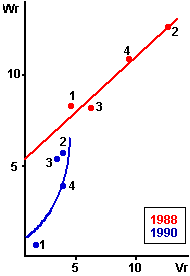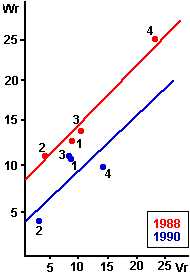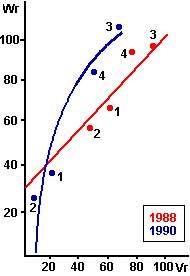 |
Genetic Collection of Flax in VIR Department of Industrial Crops |
|
 |
Genetic collection of flax includes lines with different morphological and agronomic characters. Genes of colours of flower organs and seeds and genes of rust resistance are identified. Heredity of earliness and plants height is described.
Contemporary breeding process requires utilisation of maximum available knowledge of particular crop genetics. On one hand, data about quantity of genes, controlling agricultural characters, there place on the chromosomes and interactions between each other gives to breeders an opportunity to transfer needed characters to new variety in shortest time. On the other hand, without identification of genes of morphological characters it is impossible to create detailed genetic maps of the crop. At present scientific knowledge about flax genetics is very poor. Nothing is known about number of genoms in flax careotype. Concerning groups of linkage, we can say that only 3 pairs of linked genes were discovered till now. In general, in flax a very few genes are identified yet, because of some specific features of the species. The main reason of these difficulties is the lack of morphological differences between accessions. Only colours of flower organs have sufficiently wide spectrum of diversity. Seeds also can have different colours. Some genes, which control colour of flowers, have plaiotropic effect on seeds colour. But there are genes influencing only colours of the seeds. In spite of the great influence of environment on hue these traits can be used as genetic markers. Now about 30 genes, controlling flower colours are identified, but some of them have identical phenotypes and types of inheritance. So, these genes could be the same, but nobody made test for allelism.
Another more or less well studied group of genes controls vertical resistance to rust. Flor identified 30 genes of rust resistance in 5 locuses. The identification of particular R-gene requires itís interaction in test with particular clone of fungi. So, we never can say that all resistance genes are known, because application of new races of pathogen may distinguish new genes and locuses of resistance. Lines with different genes of rust resistance could be used for genetic marking and as donors of resistance in breeding programs.
The majority of valuable agronomic characters are quantitative traits and usually have poligenic inheritance. But for successful breeding it is very important to know as much as possible about genetics of these characters. The main part of such kind of trials in flax was devoted to genetics of duration of vegetative period and plants height. On different material different variants of dominance and genes interactions were discovered. The reason of genetic analyses difficulties is that until now we donít have sufficiently good method for identification of genes, controlling quantitative characters. But several methods can give as information about genetic potential of lines - there ability to pass needed characters to the progeny, that is to be a donors of the trait.
The first step of studying and using of particular crop genetics in practice is the creation of collections of inbred lines with identified genes, controlling different characters.
The creation of flax inbred lines collection with different morphological and agronomic characters is carried out in the department of industrial crops in VIR. Now this collection consists of more then 200 lines, carrying different traits of petal, anther and seed colour, petals shape, resistance to different rust clones, different duration of vegetation phases and plants height. Genetic analyses of some of them have been already carried out.
Reciprocal hybrids of F1 and F2 between these lines was studied in field conditions. In all variants no reciprocal differences were found. In genetic analyses 6 genes, controlling colours of petals, anthers and seeds were identified. All of them have analogues in the list of genes, identified by Plonka (1956), but as we donít have original French lines in our collection, we canít carry out test for allelism. Here we give the list and description of genes, identified in lines of our collection:
- pf1 - pink petals, orange anthers and light brown seeds (phenotype is identical to ad gene, identified by Plonka, 1956)
- RPF1 - reduced pink colour of petals, manifest itself in genotype pf1, acts only in petals (phenotype is identical to Lr gene, identified by Plonka, 1956)
- sfc1 - strengthens blue petals colour (PF1-) to violet and pink (pf1 pf1) - to dark pink, acts only in petals (phenotype is identical to nf gene, identified by Plonka, 1956)
- wf1 - white colour of petals, acts only in petals, codominant (phenotype is identical to nc gene, identified by Plonka, 1956)
- ora1 - orange anthers and pollen, acts only in anthers, manifest itself in genotype PF1- (phenotype is identical to ah gene, identified by Plonka, 1956)
- rs1 - light brown seeds, acts only in seeds, manifest itself in genotype PF1- (phenotype is identical to rm gene, identified by Plonka, 1956).
It must be mentioned that genetic analyses showed presence of polymeric genes, modifying hue of yellow-brown seeds in genotype pf1pf1. In F2 of cross between l-1 k-48 and l-1 k-6815 all plants with pink flowers had dark yellow-brown seeds. In F2 of cross between l-1 k-48 and l-1 k-6917 pink-flowered plants showed segregation of yellow-brown hue of seeds. Different hues of colour formed eternal row of variance with transgressions to both sides. F1 of l-1 k-6917 x l-1 k-6815 had intermediate colour of seeds. F2 variance row had transgression to the light side.
In collection we have lines with other phenotypes of flower organs and seeds colour. The genetic analyses of these traits is not finished yet
Identified genes, controlling colours of flower organs can be used not only as genetic markers, but also for marking new varieties to help there identification.
In genetic collection of our institute there are 29 lines containing 30 genes of rust resistance (Table 2), identified by Flor and located in 5 locuses: K, L, M, N and P (Islam, Mayo, 1990).
In case of genetics of vertical resistance to the diseases identification of genes alleles is possible only with the help of inoculation by particular race of fungi. If population does not have some genotypes of pathogen, it is impossible to identify plant genes of resistance to these particular races of fungi. Described in bibliography genes of rust resistance were identified by clones, isolated from Australian population of fungi. Genetic analyses with the use of Russian population of fungi discovered one more dominant gene - Q, which is not allelic to any of previously known genes. Gene Q was found in lines, possessing genes N, N1, L4 and K.
Collection of rust resistant lines now in our institute is widely used for creation of resistance donors on the basis of the best varieties, cultivated in Russia.
Lines with different duration of vegetative period and its stages are also represented in genetic collection. These lines have different height of the plants. The results of field evaluation of some lines is presented in Table 3. One can see that year conditions have great influence on quantitative characters.
Genetic analyses of described characters was carried out for these lines using method of Mather and Jinks (1982). Field evaluation of lines and there F1 hybrids, obtained from diallel crosses was made two times: in 1988 and 1990. Being a quantitative characters, these traits have poligenic inheritance.
 |
 |
 |
| Dependence between Wr and Vr in diallel crosses for characters: duration of period from germination till appearance of the first flower (left), duration of period from appearance of the first flower till ripening of the first boll (middle), height to inflorescence (right). 1 - 1-1, k-512; 2 - 1-1, k-48; 3 - 1-5, k-1507; 4 - 1-4, k-5896 |
||
In 1988 the duration of phase from germination till flowering was controlled by poligenic system with complemental interactions. In 1990 inheritance was different. This year an additive-dominant model of genes interaction could be applied for characterisation of genetic system. These results showed that in different environmental conditions set of genes, controlling quantitative character can change. It happens because different particular genes act in different conditions of temperature, humidity, nutrition, etc. But the distribution of quantity of dominant genes in lines both years was the same. So, we can say that l-1 k-512 has maximum amount of dominant genes for the short first stage of vegetation and could be used as donor of this trait.
In 1988 the trials error was too much to identify the type of interaction of genes, controlling the duration of period from flowering till maturity. The results of 1990 showed that additive-dominant model of inheritance was adequate. In bought cases l-1 k-48 had maximum dominant genes for this character.
For the height to inflorescence type of inheritance differed from year to year. In 1988 genes had duplicate interactions. In 1990 additive-dominant model of inheritance was adequate. But in any case lines, possessing maximum and minimum quantity of dominant genes, controlling this trait was identified. L-1 k-48 has maximum dominant genes for the character and can be used as donor of sufficient plant height.
The results of genetic analyses showed that the duration of phases from germination till flowering, from flowering till maturity and plants height are controlled by different genetic systems. It is very important for breeders, because it gives an opportunity to combine in one variety two short phases of vegetation and sufficient plants height (Brutch N.B.,1998). Last year we created line of fibre flax, possessing all these characters.
- Brutch N.B. (1998) Influence of growing conditions on the performance and inheritance of fibre flax characters. In press.
- Islam M.R., Mayo G.M.E., (1990) A Compendium on Host Genes in Flax Conferring Resistance to Flax Rust. Plant Breeding - 104
- Mather S.K., Jinks J.L. (1982) Biometrical genetics. London, New York
- Plonka F., Anselme C. (1956)Les varietes de Lin et leur malades. Paris, Institut National de la Researche Agronomique
| Genetic Collection of Flax in VIR |  |
